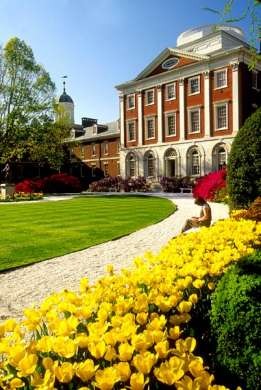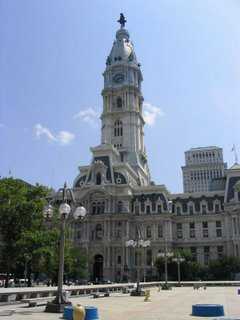Related Topics
Particular Sights to See:Center City
Taxi drivers tell tourists that Center City is a "shining city on a hill". During the Industrial Era, the city almost urbanized out to the county line, and then retreated. Right now, the urban center is surrounded by a semi-deserted ring of former factories.
Tourist Walk in Olde Philadelphia
Colonial Philadelphia can be seen in a hard day's walk, if you stick to the center of town.
Touring Philadelphia's Western Regions
Philadelpia County had two hundred farms in 1950, but is now thickly settled in all directions. Western regions along the Schuylkill are still spread out somewhat; with many historic estates.
Sixth and Walnut over to Broad and Sansom
 In 1751, the Pennsylvania Hospital at 8th and Spruce was 'way out in the country. Now it is in the center of a city, but the area still remains dominated by medical institutions.
In 1751, the Pennsylvania Hospital at 8th and Spruce was 'way out in the country. Now it is in the center of a city, but the area still remains dominated by medical institutions.
Railroad Town
 It's generally agreed, railroads failed to adjust their fixed capacity to changing demands. It's less certain Philadelphia was pulled down by that collapsing rail system.
It's generally agreed, railroads failed to adjust their fixed capacity to changing demands. It's less certain Philadelphia was pulled down by that collapsing rail system.
The Center of Town

|
| city hall |
It took two hundred years for the inhabited part of the city to reach the square which William Penn had envisioned for the center of his green country town, and by the time it did, the area around City Hall had come to resemble the town planning concepts ordinarily associated with the Scotch-Irish immigrants.
It sort of goes like this: the Scotch-Irish had been kicked out of Scotland and they were soon kicked out of Ireland, so they were far less emotionally attached to their local soil than other European groups. So they were probably the first group to regard real estate as a commodity rather than a repository of wealth, or a religious shrine, as other groups often do. It soon became evident to them that the best real estate was usually found at the crossroads, and the more important the intersecting roads, the more valuable that real estate was going to be someday. Accordingly, early Scotch-Irish settlers roamed around their new country, looking for likely crossroads, and buying up the local property for speculation.
The pattern of the diamond appeared, with a town square placed at the crossroads, traffic diverted around the square, and commercial real estate established around the rim of the square which usually had a flagpole placed in the middle of the central park. New England had city centers and town commons, but the two were usually not the same thing. The diamond pattern is very characteristic of rural Pennsylvania, and up and down the Appalachian valleys where the Scotch Irish had spread. It is the pattern of Philadelphia City Hall Square, no matter whose idea it was originally. Let's face it. City Hall is at a crossroad of the two main traffic arteries, Broad and Market Streets, wide and straight, stretching for miles in each direction.
Originally published: Monday, June 26, 2006; most-recently modified: Thursday, June 06, 2019